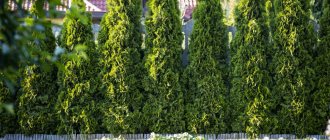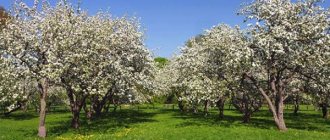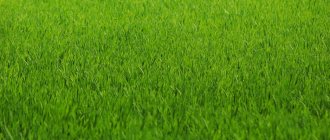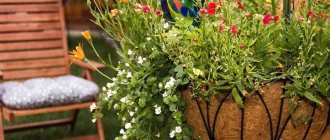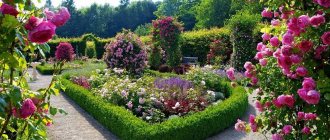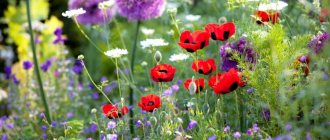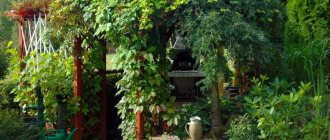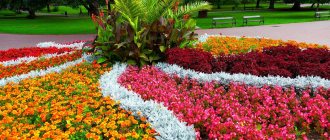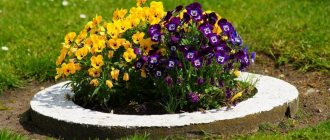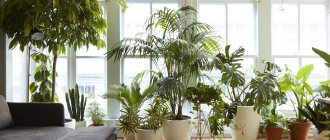Nowadays, owners of their own houses and summer cottages use different varieties of deciduous, coniferous and flowering plants. Recently, the topic of coniferous plantings for hedges was actively discussed on the forum. This is what our regular user Asya1974 writes:
Asya1974
I'm asking for advice. I want to plant 5-7 pieces of Korean fir along the front part of the fence. What I want: a beautiful, always elegant appearance, exactly a coniferous planting. Maybe consider other plants for such purposes? (but you need evergreens).
We have prepared the top 10 evergreen and deciduous plants that are suitable for creating beautiful decorative fences.
The most popular varieties and types of fir
Firs are no less popular than other plants, including conifers. Firs are long-lived trees, extremely adapted to various living conditions. They are not afraid of drought, frost, snow.
Balsam fir abies balsamea
The dense crown resembles a cone, the branches descend to the very ground. The needles are dark green on top and have light stripes underneath. The tree got its name from the balsamic smell that appears when you just rub a few needles or a pine cone in your hands.
Smooth-fruited fir or subalpine fir abies lasiocarpa
A dwarf fir that resembles a spruce in appearance. The needles are sparse, the needles are bluish, not prickly.
Korean fir abies koreana
A low, extremely slow-growing weeping conifer. The needles are soft, up to 2 cm in length, with 2 light stripes on the underside.
Purple-lilac cones form on the fir. Unpretentious, tolerates both rain and heat equally well.
Good neighborhood
When creating a mixborder from conifers, you need to know what plants they are combined with. This affects not only the decorative properties of the flower garden, but also the health of flowers and shrubs, since they can negatively affect each other in close proximity.
Coniferous-deciduous mixborder
The combination of coniferous and deciduous shrubs and trees is especially beautiful in summer and autumn. Landscape designers recommend choosing plants with bright flowers and fruits.
Barberry Thunberg
Not only does it look good and gets along with conifers. They protect him from the wind. The most successful varieties:
- diamond-shaped Aurea - golden in spring and orange in summer (no more than 80 cm);
- columnar Erecta - bright green and bright red (1 m);
- spherical Green Carpet - juicy light green and reddish (60 cm);
- funnel-shaped, spreading Golden Ring - leaves are purple-violet with a crimson tint, golden-yellow border, flowers are yellow-red, fruits are scarlet.
Spiraea japonica
Often afraid of the sun and quickly withers in the heat. Conifers retain moisture in the soil for it and provide shade. Which varieties to choose:
- gray - spring-blooming, with snow-white inflorescences on long branches and grayish-green leaves;
- Nippon - spring-flowering, spherical, with white inflorescences (sometimes with red splashes) and green oval leaves;
- Golden Princess - spherical, squat, with lilac or pinkish flowers, collected in round inflorescences, and light green jagged leaves;
- Little Princess is spherical, with bluish-green oval-elongated foliage and light pink flowers.
Forsythia
It looks like a bright yellow spot in the coniferous mixborber, drawing the eye to the flower garden. Recommended varieties:
- European - with single bell-shaped yellow flowers;
- drooping - spreading, with small golden flowers collected in inflorescences, dark olive branches;
- dark green - with rich green jagged leaves and green-yellow flowers, collected in small bunches;
- snowy - with oval leaves that have a purple underside; in autumn the foliage becomes purple, the flowers are large, white with a yellowish throat and a light pink center.
To create a bright, beautiful mixborder of shrubs and conifers, the former must be distinguished by either bright green foliage against the background of lush green spruce and cypress trees, or beautiful flowers, or expressive fruits.
Mixborders with conifers and perennials
Such flower beds are suitable primarily for those who do not have time to care for them every day, if you manage to visit the site once every 2-3 weeks and then only on weekends.
Roses
The most luxurious is considered to be a mixborder made of conifers and roses. The juicy needles and incredibly beautiful buds look great. Which varieties are suitable:
- compact bush;
- hybrid tea;
- climbing;
- polyanthaceae;
- ground cover;
- remontant.
However, remember that of all perennials, roses require the most care. In particular, they need to be trimmed and supported in a timely manner. And another difficulty in creating such a mix is that these flowers love the sun, while conifers love the shade. Therefore, you need to carefully look for a place to locate a flower garden, and the plants themselves should not be planted close to each other.
Hydrangeas
They create a noble mixborder in which, in principle, no other plants will be needed. Recommended:
- spreading and compact Anabel with spherical white flowers;
- spherical Grandiflora with flowers that change their color several times: light green - white - cream;
- round Sterilis with dense inflorescences, which during the summer change shade from greenish to white;
- paniculate fan-shaped Kuishu with ovate beautiful leaves and white flowers.
Hydrangea uses the proximity of conifers to its benefit, as they provide it with the moist soil that it loves so much.
Chrysanthemums
Here you need to know a couple of nuances:
- It is better to plant low-growing varieties of chrysanthemums next to creeping and ground-cover coniferous plants;
- and vice versa: tall, bush-like chrysanthemums - with pyramidal and cone-shaped coniferous trees;
- Usually spherical varieties of hydrangea are chosen;
- White, yellow and red varieties of chrysanthemums should be planted against the background of green conifers.
Indian, Korean, autumn, prominent, seeding and odorless chrysanthemums look good.
With annuals
Such mixborders can be created only by those who have time to care for annual flowers, which require regular watering, fertilizing, loosening the soil and other useful procedures. Which ones are suitable:
- balsam that blooms brightly until frost: New Guinea garden, Hokera, large-flowered, creeping, Camellia, Impatiens Waller;
- marigolds with their variety of shades from bright sunny to deep burgundy;
- hybrid verbena - with small but bright flowers of a wide variety of shades - blue, purple, red, white, pink, blue, peach.
For the first tier of a mixborder with tall conifers, annuals such as asters, violets, pushkinia, galanthus, bells and irises are also suitable.
Mixborder of conifers and cereals
This is a classic of the genre, allowing you to eliminate bright spots in the garden, which sometimes irritate the eye with too lush flowering and a variety of shades. Only greens - and nothing more. The following cereals are suitable:
- gray fescue;
- Pogonaterum millet;
- Italian setaria;
- maned barley;
- cortaderia;
- pinnately bristly, American, shaggy;
- miscanthus;
- haretail.
A particularly interesting ensemble is obtained from any of the cereals with various varieties of decorative juniper.
Advantages
Many people organize beautiful coniferous mixborders on their plots, which allow the garden to look attractive even in winter. But this is not the only function that evergreen shrubs and trees perform within a given flower garden. Why do most gardeners choose them?
Firstly, if a mixborder consists exclusively of conifers, it turns out to be the most unpretentious flower garden, which requires a minimum of time, effort and financial costs. But this does not mean that he does not need care at all. You still need to follow the standard procedures twice a month:
- feeding with fertilizers;
- spraying against diseases and insects;
- removal of damaged branches.
In hot weather - watering. In addition, since the mixborder presupposes a fairly close planting of conifers, rot, fungus, and mildew often form in places where they touch. This is the main and almost the only problem of this flower garden. But if you regularly loosen the soil, remove yellowed needles and branches, and do timely spraying, it can be avoided.
Secondly, the decorative varieties of coniferous shrubs and trees are so diverse that you get a fairly voluminous, multifaceted flower garden. Even if you don't use other garden plants (herbs and flowers), it will still look gorgeous.
Thirdly, conifers allow you to create that gradation, which is one of the main principles of building a mixborder. The background (if it is located near a fence or wall) or the center (if it is organized as an island in the middle of the site) are the tallest plants. And the best among them are the slender, elongated cypress trees. The second layer consists of low-growing shrubs, and here it is difficult to find something more suitable than decorative varieties of mountain pine or thuja. The last row, spreading at the very feet, is the ground cover. And there is plenty to choose from: Wintergold yew, Repanda juniper, etc.
The coniferous mixborder is an excellent solution also because:
- fits into any landscape design style;
- presented in a wide variety of patterns, as it goes well with other ornamental plants: deciduous, flowering, herbaceous;
- looks great with garden sculptures.
According to data, 85% of mixborders include conifers. And now it’s clear why. They seem to have been created by nature itself for this type of flower garden. Without them, it no longer looks so rich and evergreen. So, if you are planning to create one on your site, buy decorative spruce, pine, thuja, cypress and more. Well, we have already talked about how to plant conifers correctly so as not to harm them.
The most popular varieties and types of pine
In summer cottages, pine trees are found quite often, but, as a rule, dwarf and short varieties are used, which are more convenient for growing.
Weymouth pine pinus strobus
Eastern white pine grows up to 20 m in height. The pine has a pyramidal, graceful openwork crown and thin, soft, bluish-colored needles. Large cones hang on long cuttings.
Mountain pine pinus mugo
A low-growing shrub with a creeping crown, grows extremely slowly. It grows sideways up to 3 m. The needles are long, hard, dark green. The cones are light brown, sessile, small. They look like decorative ornaments.
Features of planting hedges
A green fence will stand in one place for many years, so the planting procedure must be approached very responsibly.
Time
Conifers are most often planted in open ground in early spring. When the heat comes, it is harder for plants to take root. During the season, trees and shrubs have time to take root well and survive the winter safely. It is also allowed to plant coniferous crops in the autumn.
The younger the plant, the easier it takes root.
But if there is a need to replant an adult tree, then the best time for this is winter.
Soil preparation
The area is cleared of plant debris and dug up. If the soil is depleted, mineral and organic fertilizers are applied.
The best option for planting conifers would be a substrate consisting of loam, humus, and sand.
If the soil is acidic, lime is added to it. Alkaline soil is acidified with peat.
Planting scheme
To create a hedge, perform the following steps:
- In the selected area, pull the rope so that a straight line is formed.
- Planting holes are dug at a certain distance.
- A drainage consisting of small stones, expanded clay, and sand is laid at the bottom.
- Fill the wells with the prepared substrate.
Plants are planted in one or two lines.
Depending on the variety and variety of conifers, the interval between them is maintained at 40-60 centimeters.
Hedge planting scheme
The nuances of caring for a green fence: how to water, cut and feed
The ground under the hedge is irrigated once a week. The water should flow slowly, seeping deep enough into the ground. Watering is done in the morning or evening. In addition, the crown of yew, thuja, and cypress can be sprayed in the morning. Dry humus is used to enrich the soil with nutrients. They sprinkle it on the soil around trees and shrubs. In spring, conifers can be fed with nitrogen. In summer, complex mineral fertilizer is used. In the second half of spring, they begin to trim the hedges. No more than a third of the shoots are cut off at a time. The instrument is pre-sharpened and disinfected. To add splendor to the green fence, the side shoots of the plants are pinched. In addition, they carry out sanitary pruning, removing broken, dry branches.
Advantages and disadvantages of coniferous hedges
An evergreen fence has the following advantages:
- There is a large selection of crops on the market that are suitable for building as a green fence.
- The life cycle of trees and shrubs is tens of years. Having planted the plants once, the gardener will only give the hedge its shape.
- Conifers look decorative throughout the year.
- There is no need to build a permanent fence. Tall plants will hide the garden area from prying eyes.
- Most coniferous trees can withstand frosts down to -45°C without shelter for the winter.
- A green fence will protect the area from dust, shade it from the scorching sun, and muffle sounds.
- Coniferous plants secrete phytoncides that have a beneficial effect on the human body.
The disadvantages of hedges include the following factors:
- In the southern regions, needles can burn out from excess hot sun rays.
- If one of the mature trees dies, there will be a void that will not be filled quickly.
- One of the advantages can also be a disadvantage: due to the shade created by the green hedge, other plants will not be able to develop.
Caring for a living fence is not difficult: you need to water it as needed, periodically feed it, and trim the crown. Having once planted conifers on the plot, the gardener will admire the wall of evergreens for a long time.
The best coniferous plants for hedges
The gardener chooses trees and shrubs depending on his preferences. You also need to focus on the climatic conditions of a particular region. Not all conifers tolerate heat or frost equally well.
Thuja
To create a hedge, gardeners use 3 popular varieties of thuja: Brabant, Smaragd, Columna.
Brabant
The advantage of the tree is its rapid growth and ability to withstand severe frosts. Thuja Brabant in urban areas can grow to a height of 4 meters, so it is used to create a high hedge. There is a beautiful variety of the variety: Golden Brabant.
The plant retains yellow-golden needles throughout the year.
Thuja Brabant
Emerald
The height of the tree is 4-6 meters. Annual growth is 20 centimeters. Thuja Smaragd, shaped like an elongated cone, is covered with thick green needles. The plant tolerates frost well and can be pruned.
The decorative effect of the shoots remains throughout the year.
Thuja Smaragd
Columna
The tree has a columnar crown. The shoots extend to a height of 3 meters, but can reach a length of 9 meters. The needles, green in summer, turn brownish in winter.
In the first years after planting, Thuja Columna needs shelter for the winter.
This is an ideal plant for a hedge because it does not form voids or gaps in it.
Thuja Columna
Spruce
The following varieties of culture are popular:
Prickly spruce
The color of the needles, depending on the variety, can be khaki, green, or silver. The crown height varies between 0.5-2.5 meters. The prickly blue spruce Glauka is in great demand. It belongs to light-loving crops. The more sun, the more decorative the needles look.
Prickly spruce Glauca Picea pungens glauca
Canadian spruce
One of the famous representatives of the culture is the Konika spruce, reaching a height of 2 meters. Its lower shoots are very densely located, due to which the density of the living wall is achieved. It can be planted by gardeners living in regions with high air humidity.
Canadian spruce Konica
Norway spruce
Ephedra is popular because of its unpretentiousness, delicate green needles. The ends of the horizontal shoots are slightly raised upward. Norway spruce used as a fence will give the garden a unique look throughout the year.
Norway spruce
Pine
Breeders have developed crop varieties of different heights. Depending on the size of the local area and the weather conditions of the region, the gardener selects the right conifer. Scots pine Argenta Compacta, Weymouth Blue Shag, and Mountain Mugus are popular.
Scots pine Argenta compacta
An adult tree reaches a height of 2-2.5 meters. The crown is hard, dense, wide-conical. The needles are colored green-blue. Safely tolerates severe frosts.
A hedge made of Scots pine Argenta Compacta is suitable for a medium-sized plot.
Scots pine Argenta compacta
Weymouth Pine Blue Shag
This is a fast-growing variety that has the shape of a wide pyramid. The needles are colored bluish-green. Pine prefers to grow in sunny areas. It does not make any great demands on the composition of the soil, but it develops better in moist soil.
Weymouth Pine Blue Shag
Mountain pine Mugus
The culture reaches a height of 2-3 meters. Pine has a very decorative appearance, especially when light brown cones appear. In spring the needles are light green. By autumn it acquires a dark green color. The tree grows in any soil.
Mountain pine Mugus
Juniper
There are several varieties used to create hedges.
Common juniper
The trees extend to a height of up to 10 meters. The cone-shaped crown of the common juniper is colored green.
The undemanding conifer successfully withstands lack of care.
A fence made from it can last for several decades.
Common juniper
Red cedar
Small scaly needles of a dark green color are formed on the tree. It grows in the form of a cone or an open funnel. Over time, the lower part of the plant becomes bare. Therefore, it is recommended to plant other crops in the foreground, covering the bottom of the conifer.
Red cedar
Chinese
Can grow as a tree or shrub. Small, spherical bumps form on it. Chinese juniper tolerates the scorching rays of the sun well, but can freeze in harsh winters. Popular crop varieties: Stricta, Blue Alps, Spartan, Mint Julep.
Chinese juniper
Cossack
Shoots of the bush rarely exceed a height of 1.5 meters. The branches grow wider than tall. The needles are soft and tender to the touch. Cossack juniper grows slowly and lends itself well to pruning.
Due to its strong, well-developed root system, it tolerates short-term drought well.
Juniper Cossack
Scaly
The variety is distinguished by a bluish tint of needles. The branches are wide and creeping. The 1.5 meter tall shrub emits a pleasant pine aroma.
Prefers to grow in a well-lit place. Popular varieties: Blue Carpet, Blue Sweet, Blue Spider, Blue Star.
Juniper scaly Blue Carpet
Yew
To create a hedge, two types of yew are most often used: berry and Canadian.
Berry
This is a slow growing crop that prefers shade. At first, the yew berry has the shape of a bush. Only after a few decades will it grow into a tree. Over time, mini buds form, often called berries.
The seeds are poisonous, so the fruits should not be eaten.
In order for cones to form, both male and female plants must grow side by side. Yew bushes are planted at a distance of 50 centimeters. When forming a hedge, you need to make sure that the trunk of the bush is not exposed. The shrub develops best on clay soil to which lime has been added.
Yew berry
Canadian
Yew reaches a height of 1-2 meters. The shoots are widely spread, densely covered with needles. In winter it turns red-brown in color. Each branch grows 5 centimeters in a year.
This plant is frost-resistant, so it can be planted by residents of cold areas.
Canadian yew
Cypress
Gardeners plant cypress hedges of the following varieties:
Aurora
The height of the plant is about 90 centimeters. The crown spreads over a width of 0.6 meters. The Aurora cypress is distinguished by thick yellow-green needles.
It will grow well in a sunny area.
Cypress Aurora
Lawson
The tree reaches a height of 3.5 meters and a width of 120 centimeters. The crown has a cone shape. The needles are green, with a bluish tint.
It grows slowly and tolerates frost well. Cypress has good immunity and is rarely affected by diseases and pests.
Lawson's cypress
Fernsprey Gold
A slow-growing crop in adulthood reaches a height of 3 meters. It has a wide pyramidal, dense crown. Cypress has curved, fern-like, flat branches. The needles are colored golden yellow. Grows in sunny or partial shade.
Cypress Fernsprey Gold
